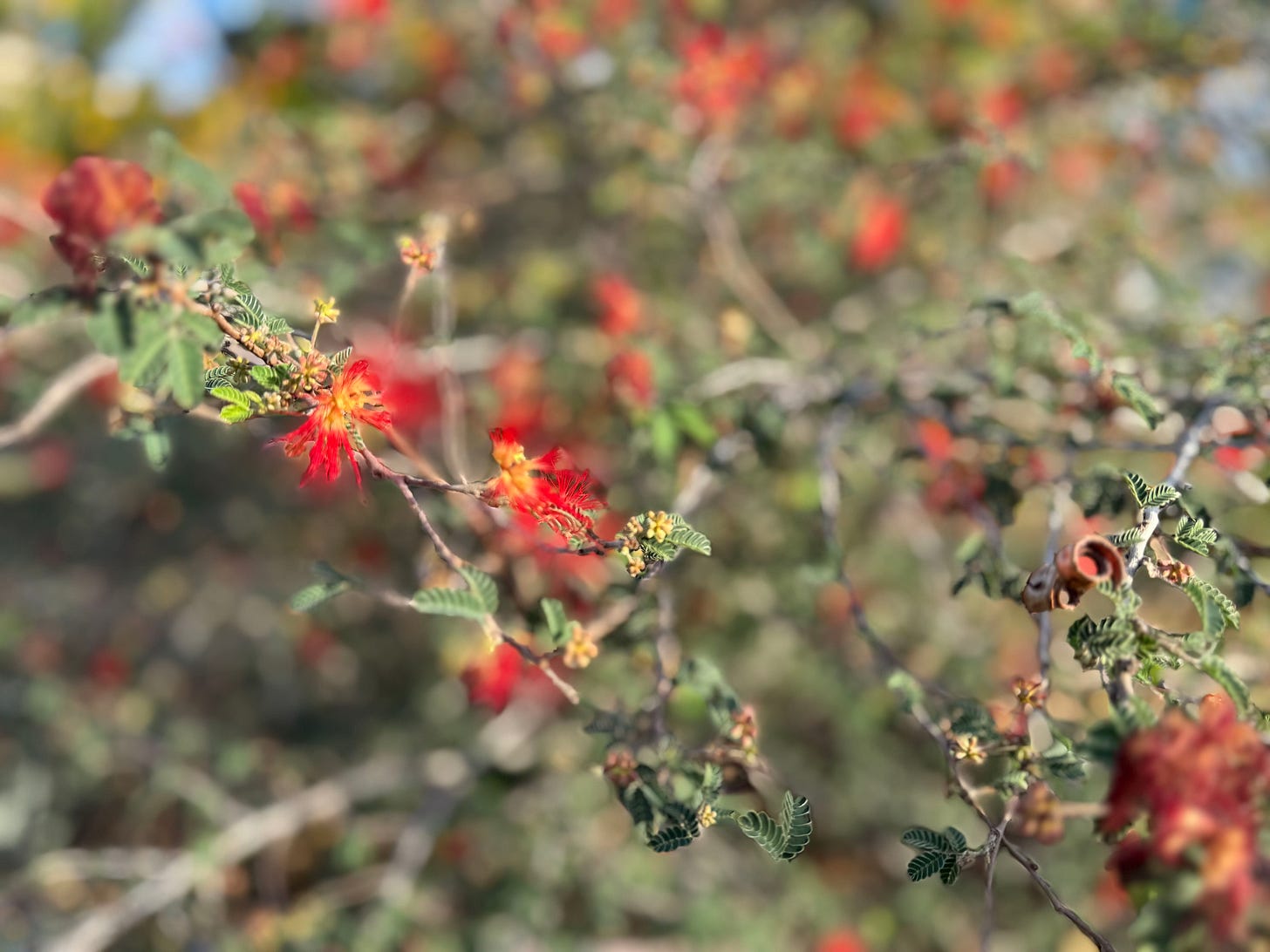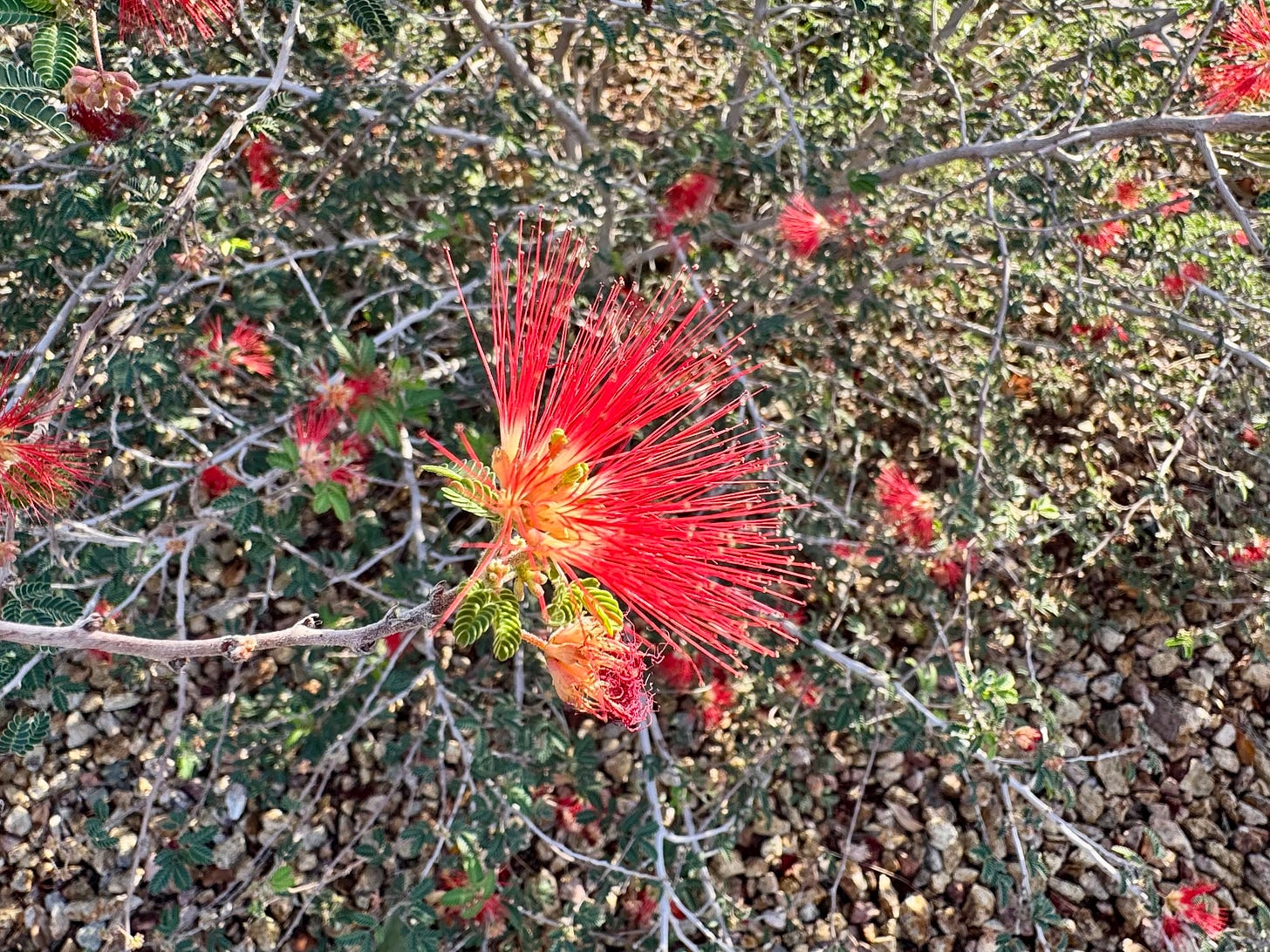Baja Fairy Duster is an Effortlessly Cool Shrub For the Hot, Dry Garden
Try planting several together for an ethereal, desert dreamscape
Baja fairy duster (Calliandra californica) is effortlessly cool. Like that charming jock in high school with the perfectly disheveled hair. Like him, this plant is lavished with attention.
The pollinators have come to the garden ahead of the day’s heat. I hear them in early morning light. It is the sound of pressurized water vaporizing in hot air. Perhaps there is a fine leak in the drip system; a precious resource squandered. As I get closer, the sound intensifies, becoming a sawmill.
I see the Baja fairy dusters now. They have turned animate, alive with hundreds of honeybees feasting on this rugged shrub’s bounty of pollen and nectar. The hummingbirds will have to wait their turn for their favorite-colored flower, which look like fiber optic lights: a bright, light-catching red. The color sits almost exactly opposite the blue of desert sky on the color wheel.
I do not know why these resilient shrubs are not planted more often. They are readily available at nurseries in southern Nevada. It may be that the young plants, in five-gallon pots, look small and twiggy. It takes a while to get going in the garden.
But after a few years and not much water, it will grow into a handsome shrub about as tall as it is wide, at four to five feet in our climate. The branches grow up and out, soft and slender, as leaves, tiny and mesquite-like, unfurl. The leaves become nearly glaucous with age, and they are evergreen. Fairy dusters lose some of their leaves in a Mojave winter and during the hottest time of the year before rains come. The leaves are a nice contrast to the bright red flower puffs. The bark is the color of bone.
Baja fairy dusters grow wild in ravines and washes in Baja California; in the landscape, water should be deep and infrequent. The more infrequent the better. As with all arid plants, size is controlled not with shears, but with water. Give a desert plant a lot of water and you will get a large, spoiled plant. Spare the water and you’ll never have to prune this at-home-in-the-desert shrub.
If your Baja fairy dusters get too large (which is unlikely in southern Nevada), prune by cutting out older canes at the base of the plant. Don’t be shy about it. All shrubs take well to being cut back to the ground on occasion—they are made for it. In the wild, shrubs are pruned by fires, floods, drought, and herbivores.
I would like to see more of these plants, and lots of them, in Las Vegas landscapes. The effect of all those delicate, frothy flowers would be a dreamscape equal to the likes of Piet Odoulf’s gardens and the wonders of the New Perennial movement.
When designing with this plant, consider that the rounded, fountain shape has a tendency to draw the eyes down. Native beavertail (Opuntia basilaris) could be used to great advantage here, creating a sort of visual loop whereby the fairy duster draws your eyes to the cactus, whose pads then point you back to the arching branches of this shrub. A garden massed with these two plants would benefit from punctuation marks to break the cycle of eternal return, a miniaturized flirtation with infinity.
Mexican fence post (Lophocereus marginatus) and San Pedro (Echinopsis pachanoi) are probably too green, but they are the right form, firmly upright in their growth. The fence post cactus has the benefit of bone-colored spines, which match the stems and branches of the fairy duster. Plant these three plants in a loose, natural formation that appears as effortless as the fairy duster itself.
If your microclimate is such that winter is not too cold, then some variety of organ pipe cactus (Stenocereus thurberi) would work well, though it will replace fairy duster as the main visual element in the garden.






